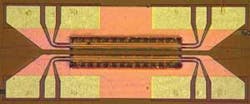Hybrid silicon MZM-based switch operates at 10 Gbit/s
Integrated silicon (Si)-based optical-communication networks don’t just need light sources, amplifiers, and detectors; they need switches, too. A new high-speed Si-based evanescent Mach-Zehnder modulator (MZM) created by researchers at the University of California Santa Barbara takes the hybrid approach, in which III-V semiconductor structures with quantum wells (QWs) are located atop 0.04-µm-wide waveguides fabricated on a Si wafer. The result is an all-optical 10 Gbit/s switch that has a large optical bandwidth (on the order of 100 nm) and can be scaled to larger devices, such as 32 × 32 nonblocking switches.
Two multimode-interference devices in the Si function as the splitter and combiner. Tapers in the Si and III-V sections reduce mode mismatch between the passive and hybrid portions. The III-V (aluminum gallium indium arsenide) sections contain QWs and separate confinement heterostructures; coplanar waveguides are used as the traveling-wave electrode to achieve high-speed modulation. Light at 1550 nm is fiber-coupled into and out of the waveguides. High-speed testing (with a 25O termination) showed an 8 GHz cutoff frequency; when tested with a pseudorandom bit-sequence pattern, the device showed a clear, open “eye” diagram at 10 Gbit/s. The rise and fall time of the switch is 50 ps. Contact Hui-Wen Chen at [email protected].
